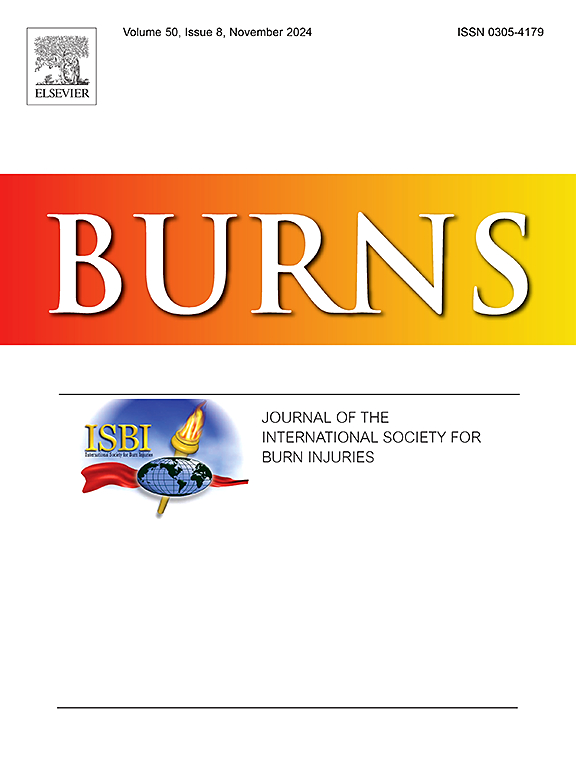在300天的观察期内,建立了一种新型的大烧伤后瘢痕动物模型,成功率高达70% %
IF 2.9
3区 医学
Q2 CRITICAL CARE MEDICINE
引用次数: 0
摘要
在所有类型的伤害中,烧伤是最容易产生疤痕的一种。然而,缺乏合适的动物模型进行研究。本研究旨在建立一种简便可靠的烧伤瘢痕动物模型,并对其特征进行系统评价。方法采用热液(94℃-98℃)对大鼠进行深度二度烧伤,烧伤面积约占体表面积(TBSA)的30% %。伤口精心包扎,每1-3天更换一次敷料。进行多变量分析以探索建模的关键因素。建模后从第0天到第300天观察宏观特征及其时间演变。采用皮肤超声评价其理化性质。采用血红素-伊红(HE)染色、Masson染色和免疫组织化学染色评估一般组织学特征和特定细胞的动态分布。Western blotting和小天狼星红染色定量胶原蛋白Ⅰ和胶原蛋白Ⅲ的含量和比例。结果烧伤后40天瘢痕形成、大鼠体重增加、创面敷料更换频率增加与造模成功率高有关。宏观上,疤痕表现出明显的粉红色色素沉着,紧致度增加,没有新的毛发生长,长期收缩。超声成像和组织病理学染色显示表皮和真皮厚度增加。与正常皮肤相比,瘢痕的真皮密度和含水量降低,经皮失水率、血红蛋白含量和弹性回缩率升高。显微镜下,瘢痕表现为表皮和真皮层明显增厚,皮肤附属物减少,胶原纤维束丰富。与正常皮肤相比,疤痕中活化的成纤维细胞和微血管明显增加;胶原蛋白Ⅰ、胶原蛋白Ⅲ含量和胶原蛋白Ⅰ/胶原蛋白Ⅲ比值增加。结论我们构建的大鼠烧伤瘢痕模型连续观察300 d,复制了烧伤后瘢痕复杂的生物学特征,方法简单可靠,成功率高达70% %以上。本文章由计算机程序翻译,如有差异,请以英文原文为准。
A novel animal scar model after major burn with a high success rate of >70 % during an observation period of 300 days
Background
Among all types of injuries, burns are one of the most prone to inducing scars. However, there is an absence of appropriate animal models for research. This study aimed to establish an easy and reliable animal model for major burn-induced scarring and evaluate its characteristics systematically.
Methods
Rats were subjected to deep second-degree burns covering approximately 30 % of the total body surface area (TBSA) using hot liquid (94℃-98℃). Wounds were meticulously dressed, and the dressing was changed every 1–3 days. Multivariate analysis was performed to explore the critical factors for modelling. Macroscopic features and their temporal evolution were observed from day 0 to day 300 after modelling. Skin ultrasound was used to assess physicochemical properties. Haematoxylin-eosin (HE) staining, Masson staining, and immunohistochemistry staining were performed to evaluate general histological characteristics and the dynamic distribution of specific cells. Western blotting and picrosirius red staining were performed to quantify the content and ratio of collagen Ⅰ and collagen Ⅲ.
Results
Scar formation around 40 days post-burn, higher rat weight, and wound dressing change frequency were associated with a high success rate of modelling. Macroscopically, scars exhibited distinctive pinkish pigmentation, increased firmness, absence of new hair growth, and long-term contraction. Ultrasound imaging and histopathological staining revealed an increase in the thickness of the epidermis and dermis. Compared with normal skin, diminished dermal density and water content, and elevated transepidermal water loss rate, haemoglobin content, and elastic retraction rate were revealed in scars. Microscopically, scars manifested marked thickening of the epidermis and dermis, diminished skin appendages, and abundant collagen fibre bundles. Activated fibroblasts and microvessels were significantly increased in scars compared with those in normal skin; moreover, collagen Ⅰ and collagen Ⅲ content and collagen Ⅰ to collagen Ⅲ ratio were increased.
Conclusion
The burn scar model in rats we constructed and continuously observed for 300 days replicates the intricate biological characteristics of scars post-burn, with simple and reliable methodology and a high success rate of more than 70 %.
求助全文
通过发布文献求助,成功后即可免费获取论文全文。
去求助
来源期刊

Burns
医学-皮肤病学
CiteScore
4.50
自引率
18.50%
发文量
304
审稿时长
72 days
期刊介绍:
Burns aims to foster the exchange of information among all engaged in preventing and treating the effects of burns. The journal focuses on clinical, scientific and social aspects of these injuries and covers the prevention of the injury, the epidemiology of such injuries and all aspects of treatment including development of new techniques and technologies and verification of existing ones. Regular features include clinical and scientific papers, state of the art reviews and descriptions of burn-care in practice.
Topics covered by Burns include: the effects of smoke on man and animals, their tissues and cells; the responses to and treatment of patients and animals with chemical injuries to the skin; the biological and clinical effects of cold injuries; surgical techniques which are, or may be relevant to the treatment of burned patients during the acute or reconstructive phase following injury; well controlled laboratory studies of the effectiveness of anti-microbial agents on infection and new materials on scarring and healing; inflammatory responses to injury, effectiveness of related agents and other compounds used to modify the physiological and cellular responses to the injury; experimental studies of burns and the outcome of burn wound healing; regenerative medicine concerning the skin.
 求助内容:
求助内容: 应助结果提醒方式:
应助结果提醒方式:


